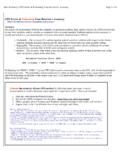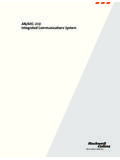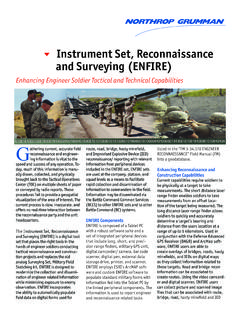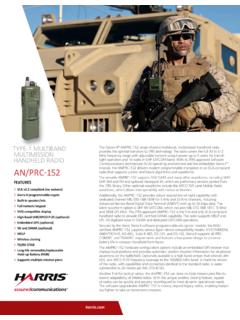Transcription of 51' - Defense Technical Information Center
1 I 51'. i Approved for Open Publication Reference Number: 14-S-0553. Form Approved Report Documentation Page OMB No. 0704-0188. Public reporting burden for the collection of Information is estimated to average 1 hour per response, including the time for reviewing instructions, searching existing data sources, gathering and maintaining the data needed, and completing and reviewing the collection of Information . Send comments regarding this burden estimate or any other aspect of this collection of Information , including suggestions for reducing this burden, to Washington Headquarters Services, Directorate for Information Operations and Reports, 1215 Jefferson Davis Highway, Suite 1204, Arlington VA 22202-4302.
2 Respondents should be aware that notwithstanding any other provision of law, no person shall be subject to a penalty for failing to comply with a collection of Information if it does not display a currently valid OMB control number. 1. REPORT DATE 3. DATES COVERED. 2. REPORT TYPE. JAN 2014 00-00-2014 to 00-00-2014. 4. TITLE AND SUBTITLE 5a. CONTRACT NUMBER. Unmanned Systems Integrated Roadmap. FY2013-2038 5b. GRANT NUMBER. 5c. PROGRAM ELEMENT NUMBER. 6. AUTHOR(S) 5d. PROJECT NUMBER. 5e. TASK NUMBER. 5f. WORK UNIT NUMBER. 7. PERFORMING ORGANIZATION NAME(S) AND ADDRESS(ES) 8. PERFORMING ORGANIZATION.
3 REPORT NUMBER. UnderSecretary of Defense Acquisition, Technology & Logistics,3010. Defense Pentagon,Washington,DC,20301-3010. 9. SPONSORING/MONITORING AGENCY NAME(S) AND ADDRESS(ES) 10. SPONSOR/MONITOR'S ACRONYM(S). 11. SPONSOR/MONITOR'S REPORT. NUMBER(S). 12. DISTRIBUTION/AVAILABILITY STATEMENT. Approved for public release; distribution unlimited 13. SUPPLEMENTARY NOTES. 14. ABSTRACT. 15. SUBJECT TERMS. 16. SECURITY CLASSIFICATION OF: 17. LIMITATION OF 18. NUMBER 19a. NAME OF. ABSTRACT OF PAGES RESPONSIBLE PERSON. a. REPORT b. ABSTRACT c. THIS PAGE Same as 168. unclassified unclassified unclassified Report (SAR).
4 Standard Form 298 (Rev. 8-98). Prescribed by ANSI Std Z39-18. This page intentionally left blank. ii UNMANNED SYSTEMS INTEGRATED ROADMAP. FY2013-2038. IS. APPROVED BY.. FRANK KENDALL. : Under Secretary of Defense (AT&L). iii This page intentionally left blank. iv Executive Summary Unmanned systems continue to deliver new and enhanced battlefield capabilities to the warfighter. While the demand for unmanned systems continues unabated today, a number of factors will influence unmanned program development in the future. Three primary forces are driving the Department of Defense 's (DoD) approach in planning for and developing unmanned systems.
5 1. Combat operations in Southwest Asia have demonstrated the military utility of unmanned systems on today's battlefields and have resulted in the expeditious integration of unmanned technologies into the joint force structure. However, the systems and technologies currently fielded to fulfill today's urgent operational needs must be further expanded (as described in this Roadmap) and appropriately integrated into Military Department programs of record (POR) to achieve the levels of effectiveness, efficiency, affordability, commonality, interoperability, integration, and other key parameters needed to meet future operational requirements.
6 2. Downward economic forces will continue to constrain Military Department budgets for the foreseeable future. Achieving affordable and cost-effective Technical solutions is imperative in this fiscally constrained environment. 3. The changing national security environment poses unique challenges. A strategic shift in national security to the Asia-Pacific Theater presents different operational considerations based on environment and potential adversary capabilities that may require unmanned systems to operate in anti-access/area denial (A2/AD) areas where freedom to operate is contested.
7 Similarly, any reallocation of unmanned assets to support other combatant commanders (CCDRs) entails its own set of unique challenges, which will likely require unmanned systems to operate in more complex environments involving weather, terrain, distance, and airspace while necessitating extensive coordination with allies and host nations. The combination of these primary forces requires further innovative Technical solutions that are effective yet affordable for program development. The purpose of this Roadmap is to articulate a vision and strategy for the continued development, production, test, training, operation, and sustainment of unmanned systems technology across DoD.
8 This Unmanned Systems Integrated Roadmap establishes a technological vision for the next 25 years and outlines actions and technologies for DoD and industry to pursue to intelligently and affordably align with this vision. The Roadmap articulates this vision and strategy in eight chapters: Chapter 1: Introduction This chapter explains the Roadmap's purpose and scope. It examines the current unmanned environment from an inventory and budget perspective while also surveying the potential future environment. The chapter includes an operational vignette to show potential future capabilities using some of the technologies described later in this Roadmap.
9 Also, the chapter explains the reduction in budget over the next five years beginning with the President's Budget request for $ billion in unmanned systems in Fiscal Year 2013. In fact, the unmanned air domain as described in the 2014 President's Budget released to the v Congress shows a reduction in research, development, test, and evaluation and procurement funding from the previous year. Chapter 2: Strategic Planning and Policy This chapter expounds on the structure, direction, and established guidance from DoD leadership toward planning and developing unmanned systems. It briefly discusses some of the prevailing unmanned issues of the day and expresses departmental direction in their resolution.
10 Chapter 3: CCDR Mission and Capability Needs A joint perspective emerges in this chapter through a discussion of mission capabilities unique to unmanned systems and an explanation of the requirements process used to deliberately develop those capabilities to achieve improved efficiency, effectiveness, and survivability and to reduce the burden on manpower at lower costs while still meeting future operational requirements. The perspective establishes that future unmanned systems must Provide capabilities more efficiently through such attributes as modularity, interoperability, integration with manned systems, and use of advanced technologies.

















